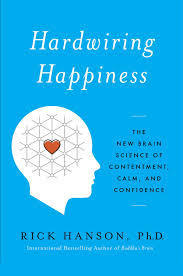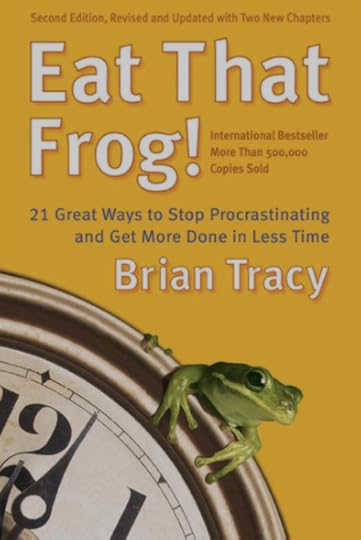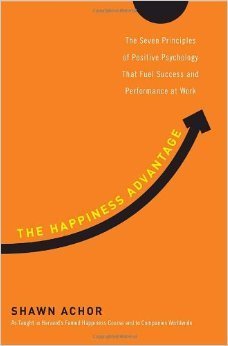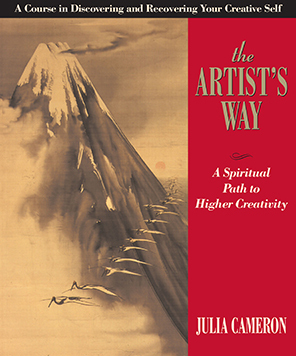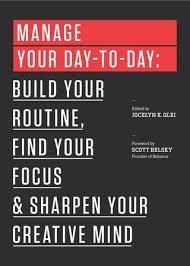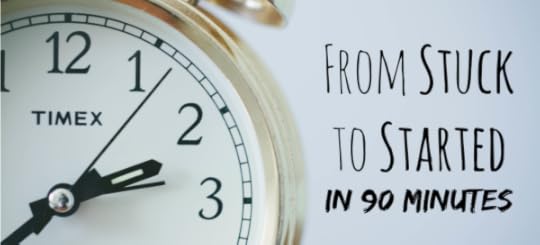Hannah Braime's Blog, page 28
November 28, 2014
6 Ways to Stop Living Someone Else’s Life
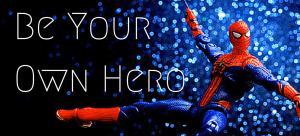 Hey friend, Be Your Own Hero is now available. This brand new e-course that gives you to the tools to deepen your courage, find your confidence, and be the creator of your own life.
Hey friend, Be Your Own Hero is now available. This brand new e-course that gives you to the tools to deepen your courage, find your confidence, and be the creator of your own life.
Get 75% off the course until 6th December. Find out more here.
How do I stop living my life based on what someone else wants me to do and start living my own life, with my own needs, desires, and ambitions?
This is a question I’ve heard from countless clients and readers and one that I’ve faced myself.
I grappled with this in my early twenties when I had what Brené Brown calls a “Breakdown Spiritual Awakening”. I was in the middle of a degree I didn’t really enjoy, looking towards career choices that were motivated by a desire for status rather than a desire for a sense of meaning, trying to play along with other people’s stories and expectations, and desperate to be accepted by someone. I was also pretty depressed, secretly self-harming and (not) dealing with a codeine addiction. Those were my consequences of not being authentic.
Shifting away from this has been a long process, and it could be a work in progress for years to come, if not a lifetime. But it is possible—the act of asking the question above means we’re conscious of what isn’t working and already part of the way there. Here are six suggestions that have helped me transition to living a life that is truer to myself, and I hope they help you too.
Look for your inner “should”sWhen we “should” ourselves, we’re arguing with reality. I’ve found when I question the things I’m telling myself I should (or shouldn’t) be doing, often these shoulds are coming from beliefs I’ve internalised from someone else or society in general.
The act of noticing and recognising doesn’t make the shoulds disappear, but it does enable us to make a conscious decision about how we respond to them.
Identify your valuesYour key values in life and work are like signposts that influence your decisions and future goals. If you aren’t sure what your key values are, the simplest way to identify them is to look at a comprehensive list of values and note the ones that resonate with you as being important. Narrow this list down to your top 10 values, then your top three (if you’re interested and would like to dig a little deeper into your values, I created a free workbook on this subject).
Once you’ve identified your most important values, write them down on a notecard and keep them in your wallet. Review them regularly and, with each decision you need to make, ask yourself: “Does this bring me closer to or take me further away from my values?”
Start keeping a life listA life list is a list of experiences or achievements that you’d like to fulfill at some point during your life. This could include anything from visiting Asia, to trying skydiving, to landing your dream job.
A life list isn’t something you need to make in one go. It’s a list you can add to as and when things occur to you, and review regularly. Because it’s a long-term process, you have a chance to listen to your deepest desires, and review on a regular basis whether or not these goals are aligned with your values and long-term vision.
Build your boundariesIf we’re used to living our lives based on other people’s needs and preferences, changing that dynamic can be challenging to our closest relationships. If other people are used to us living according to their wishes, we will need to start setting boundaries with them in order to live according to our own. This is not easy, and books upon books have been written about this topic (I recommend this one and this one; I also hosted a class on boundaries here), but the more you practice, the freer you’ll become to live your own life.
Create a future visionStart allowing yourself to daydream around the question: Where do you want to be in five years’ time and what do you want to be doing? You might have many different answers to that question, and that’s fine. Take a journal and set aside time to explore them in as much detail as possible. Remember with each idea, return to your values and ask yourself whether your dream will take you closer to or bring you further away from your values.
Notice what scares youWhen it comes to identifying the path that is true to us, the answer often lies in the things we are most afraid to do (obviously I’m referring here to our big “someday” dreams, not things that are dangerous/unnecessarily risky/illegal).
In her excellent book Playing Big, Tara Mohr describes two different types of fear, pachad and yirah. Pachad is “Projected or imagined fear,” the kind of fear we feel when we think our ego and emotional security is at risk. It feels the same as a physical threat (even though no one ever died from giving a TED talk). Yirah is the kind of fear we feel when our mind senses a growth opportunity and we have the chance to stretch our self-concept and our potential. It’s “the fear that overcomes us when we suddenly find ourselves in possession of considerably more energy than we are used to, inhabiting a larger space than we are used to inhabiting.”
With each big decision, we often experience a combination of pachad and yirah. As you contemplate your next move, focus on the yirah and that sense of tingly-growth-expansion-excitement that comes with it. Most of all, remember that just because you feel fear around doing something doesn’t mean you shouldn’t do it.
Once you start opening yourself up to life and giving yourself permission to explore the many opportunities and options available to you, you’ll realize just how much potential and possibility life holds.
Have you had the experience of transitioning from living someone else’s life to living your own? Leave a comment and share!
 If this post resonates with you, Be Your Own Hero is here. Deepen your courage, find your confidence, and be the creator of your own life with this brand new e-course.
If this post resonates with you, Be Your Own Hero is here. Deepen your courage, find your confidence, and be the creator of your own life with this brand new e-course.
Get 75% off until 6th December.
Images: Jeff Sheldon & JD Hancock
The post 6 Ways to Stop Living Someone Else’s Life appeared first on Becoming Who You Are.









November 21, 2014
#67: Finding Purpose and Passion with Izzy Arkin
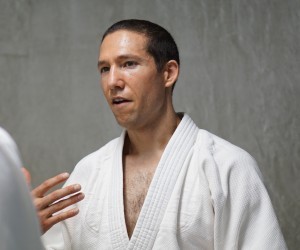 In this week’s podcast episode, I’m talking to coach Izzy Arkin from Why Not Live an Awesome Life about how we can create a life based on passion and purpose through self-reflection and awareness.
In this week’s podcast episode, I’m talking to coach Izzy Arkin from Why Not Live an Awesome Life about how we can create a life based on passion and purpose through self-reflection and awareness.
Highlights include: Why self-reflection and self-awareness are key to making changes in life The 4 key steps we all need to take to identify our purpose: asking “What matters to me?”, asking “How can I express this?” owning that we have something to give, and daring to give it How to overcome the fear of “Am I enough?” by shifting our focus inwards and asking three key questions Why it’s never too late to start asking yourself “What do I want to do with my life?”
and so much more!
Please note there is some NSFW language in this episode.
Share the Wisdom“When you say you don’t know what your purpose is, you’re really saying you don’t know yourself.” (click to tweet)
“Own that you have something to give and dare to give it.” (click to tweet)
“The greatest joy doesn’t lie in what we get. It lies in the manner in which we experience the world.” (click to tweet)
Useful LinksEmail Izzy for your values packet: izzy [at] whynotliveanawesomelive [dot] come
Say HelloIzzy
Website: Why Not Live an Awesome Life
Facebook: facebook.com/whynotliveanawesomelife
Hannah
Twitter: @becomewhour
Website: becomingwhoyouare.net
Get your free ebook on how to overcome the 5 most common blocks to authenticity.
Subscribe to the PodcastIntro and outro: Stephanie Murphy
Image credit: Owen Walters
The post #67: Finding Purpose and Passion with Izzy Arkin appeared first on Becoming Who You Are.










November 16, 2014
What’s the Most Powerful Question You’ve Ever Been Asked? 10 Coaches & Entrepreneurs Share Their Answers
I’m a big believer in powerful questions. The right question at the right time is an epic combination that can provoke powerful change—if we’re open to it. Every time I’ve experienced a shift in my thinking, it’s been because someone has asked me a powerful question, so I reached out to nine of my favourite coaches and writers to share theirs…
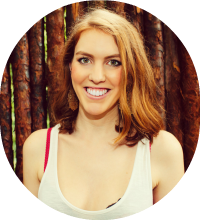 “What do you love so much that you would pay to do it every single day? How can you get paid to do that?”
“What do you love so much that you would pay to do it every single day? How can you get paid to do that?” My coach asked me this question 2 years ago as I was trying to figure out what to do with my life. It took me weeks to come up with an answer. So many things seemed worth doing, but one that I would pay to do every single day? Hm. Finally, one warm summer night I came home from a day spent in deep conversation with my mom (of all people :)) and realized: This is it. I want to spend my days being in deep conversation with people, and inspiring them to see their life differently. That’s when I decided I wanted to be a life coach.
“How do you want to feel?”This question came to me a year after I answered the first one. I was knee deep in action mode, trying to figure out how to start my business as a life coach. I was sitting in front of my laptop all day everyday, thinking that I didn’t have time for anything but work.
Then I stumbled across Danielle Laporte’s Desire Map and heard her say that we’re not chasing the goal, we’re chasing the feeling that we hope achieving it would give us. Whoa! I realized I felt like crap most days, and started figuring out how I wanted to feel instead. Small changes started adding up, and these days my life is all about the feelings – I only do things that make me feel easeful and inspired. This question can be a game changer.
– Iris Barzen, irisbarzen.com
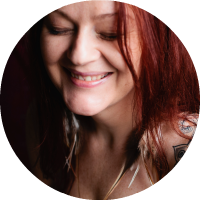 “What do you want?”
“What do you want?” Because I used to tell myself lots of stories about my wanting: that I didn’t know what I wanted, and even if I did I couldn’t have it. Wanting is often weighed down by all our crappy (often inherited) thoughts: it can make us feel needy, undeserving, selfish. When I set aside all the stuff that was in the way of what I wanted, my wants revealed themselves with certainty and clarity. Which leads me to part two:
“Who will you need to evolve into, for what you want to be yours?”So maybe you need to move out of dreaming about being an artist and put some paint on the canvas? Perhaps you need to stop writing about your future love in your journal and go on some dates! Or maybe you need to tell people that you are in training to be a coach and you’d love to share what you’re learning and how can we make this happen? Whatever the answer is for you, this question is about claiming your own power to begin walking towards the thing you want. This is never a passive exercise, often its uncomfortable – but thats the point right? On the journey of evolving into the person that has the thing you want, you will be given a hundred reasons to quit. Keep going. I promise you will meet yourself on the other side. And she is spectacular.
- Sas Petherick, saspetherick.com
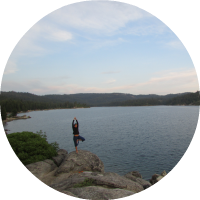 “Why?”
“Why?” The most powerful question someone ever asked me: Why? It’s so simple and so effective. Whenever I’m stuck on something and it feels like I’m going round in circles, I just ask, Why? and keep asking Why? until I get to the bottom of things. For example: I don’t know what to write about… why? Because I don’t know what would help my community. Why? I haven’t connected with them in a while. Why? I’ve been busy with other stuff. Why? That feels easier. Why? Connecting with my community means opening up, listening, being vulnerable. Ok let’s stop here. So I’m stuck on what to write because I don’t want to open up and be vulnerable. Well, there’s my answer. That’s the best place to start!
- Kendra Tanner, simplyunassuming.com
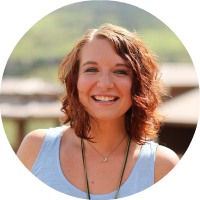 “How do you want to feel?”
“How do you want to feel?” One of the most powerful questions I’ve ever been asked is, “How do you want to feel?”
It’s funny- that is the basis for the majority of the work I do now- but 4-5 years ago, it was totally a foreign concept to me to base how I acted, what I thought, and who I interacted with based on what I wanted. I was so disconnected from my body and from the source of my emotions that I believed they were just kind of there- things that happened to me, things to try and control and ignore. It completely opened my mind to realize that instead of basing my life on what I was supposed to achieve, I could do so based on how I wanted to feel- physically/mentally/emotionally.
- Kate Marolt, katemarolt.com
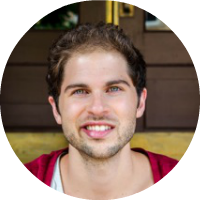 “When will you KNOW you’re ready?”
“When will you KNOW you’re ready?” This was asked to me when I felt I wasn’t ready to launch a program offering. Yet, I realized that I’ll actually never know when I’m ready, since “ready” can’t be measured. It reminded me of thinking back to a time when I was waiting for things to be perfect. In both cases, I recognized that their will never be a point when I would know that I’m ready or have reached perfection (if such a place even existed? ;p). So, now I just go for it: ready, FIRE, aim!
- Josh Barad, inthemiddleseat.com
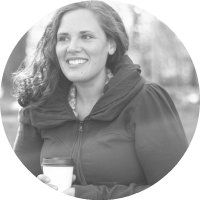 “Did anyone ever swoop in to save you from your mistakes? In retrospect, would you have wanted them to? Or, are you glad that you got to make those mistakes and learn from them on your own terms?”
“Did anyone ever swoop in to save you from your mistakes? In retrospect, would you have wanted them to? Or, are you glad that you got to make those mistakes and learn from them on your own terms?” A couple of years ago, I was coached by the brilliant Nona Jordan. During a session, she asked me, “Did anyone ever swoop in to save you from your mistakes?” and after much thought, I answered no. Then she asked, “In retrospect, would you have wanted them to? Or, are you glad that you got to make those mistakes and learn from them on your own terms?”
Wow. This triple set of questions completely rocked me – rocked the way that I relate to my clients, to my family, and to everyday conversations. There was so much permission braided into these questions. Permission for each of us to figure things out on our own. Permission for me to not have all of the answers. These questions fundamentally altered the way that I communicate with people in my daily life.
- Mara Glatzel, maraglatzel.com
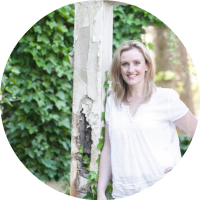 “Why do you keep bumping up against the same wall?”
“Why do you keep bumping up against the same wall?” A friend asked me this when we were discussing an issue that has continually come up for me over the years. Instead of leaning into it and being curious so that I can break through the wall and move on, I keep resisting it. She calls it the wall and I think when the wall is there, the only way we break through is by being open to what it has to teach us. When we face the wall we must accept that this is where we are, rather than resist.
- Claire De Boer, thegiftofwriting.com
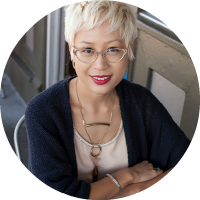 “What would you still be, even if you lost your mental acuity?”
“What would you still be, even if you lost your mental acuity?” Someone once asked me, “What would you still be, even if you lost your mental acuity?” This was during a time when I was grappling with big, scary questions about my identity in the face of troubled health — particularly my identity as a writer and a thinker, and what would happen to my sense of self if I couldn’t be those things anymore. As it turned out, a lot of the other ways in which I identify have to do with my capabilities as someone who loves and is loving. It opened a big inner conversation for myself.
- Esmé Weijun Wang, esmewang.com
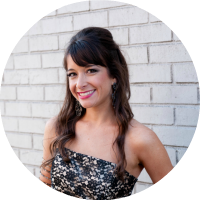 “What would it be like if you could do the thing you think you can’t do?”
“What would it be like if you could do the thing you think you can’t do?” The first time I was asked this question, it shook my world in the best way possible. Shifting my mindset and imagining how I would feel if I could do something was the jump-start I needed to actually believe I could, and then follow through to make it a reality.
– Ashley Wilhite, yoursuperawesomelife.com
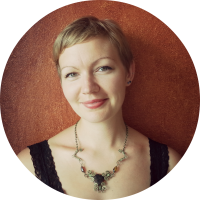 My question: “What appearances are you willing to shed to pursue your dream?”
My question: “What appearances are you willing to shed to pursue your dream?” This question comes in the final chapter of The Artist’s Way by Julia Cameron and it hit me in a deep place. The idea that pursuing our dream is not only about becoming a new version of ourselves, but also about shedding our old appearances is a powerful perspective and it left me deep in thought about the stories and beliefs I’m clinging onto in the present to keep myself small and safe.
What’s the most powerful question anyone has ever asked you? Leave a comment and share.
Are you joining us for this year’s Becoming Who You Are advent calendar? Give yourself the opportunity to reflect on the year gone by and plan for the year ahead with these free daily reflections and questions, starting December 1st.
Much healthier than chocolate and just as nourishing for the soul. Join us here.
The post What’s the Most Powerful Question You’ve Ever Been Asked? 10 Coaches & Entrepreneurs Share Their Answers appeared first on Becoming Who You Are.









November 10, 2014
How to Be Kind to Yourself in the Middle of Big Transitions
It feels like we’re surrounded by transitions at the moment: the clocks have gone back, the weather is getting colder, and we’re approaching a new year. Transitions are a natural part of life and an inevitable part of being human, yet some of us experience transitions as a source of possibility and opportunity, while others fear and try to avoid them.
The number one factor that affects how we experience transitions is how we think about them.
Click To Tweet - Powered By CoSchedule
1. Focus on what’s going well, rather than on what’s not
As people, we are natural problem-solvers. Focusing on the negative is a survival mechanism and therefore automatically kicks in during times of stress and/or change. When we start focusing on the negative, however, we risk succumbing to what psychologists call “The Tetris Effect”. This is the idea that when we develop a pattern of focuses on stress, negativity and failure, we’re going to have a stressful and negative experience of life because we’re so focused on the negative that we become blind to the positive (the name comes from the phenomenon that occurs when people play a lot of Tetris and start seeing opportunities for everyday objects to fit together in a similar fashion).
We can counter-act this by taking time to focus on what’s going well during our transition. When we do this, we’re training our brains to focus on the possibilities and potential that come with a particular situation, as well as hardships and potential disasters. This isn’t about ignoring problems, but about making sure that we’re also receptive to positive outcomes and opportunities that might arise too.
2. Make time for gratitude
Another way we can create a positive “Tetris” effect is to consciously commit to practising gratitude. This might sound a little woo-woo, but it works: when we stop to reflect on the things we feel grateful for in our lives and/or express gratitude to someone else, we feel happier ourselves. Expressing gratitude or thanking others for a positive influence they’ve had on our lives also helps us build relationships—and the stronger our relationships are, the more support we have during transitions.
You can express gratitude in the form of thank you notes or through simple practices like making a list of 20 things you feel grateful for each day.
3. Practice your non-negotiables
Non-negotiables are the activities that help us feel like the best versions of ourselves. They are usually activities that involve taking care of ourselves in some way and leave us with a sense of feeling grounded, peaceful, and fulfilled. Common non-negotiables include activities like exercise, meditation, journaling and spending time in nature.
When we’re going through a big transition and our attention is elsewhere, we tend to drop our non-negotiables to the bottom of our to-do lists. It is during these times more than ever, however, that we need to prioritise these activities. When we make time for our non-negotiables, we give ourselves the best chance of having a positive experience of the transition, prevent ourselves burning out, and set ourselves up to make decisions based on love rather than on fear.
4. Be extra wary of your coping mechanisms
If the transition is stressful, we are more susceptible to falling back on our coping mechanisms to get through. Pay extra attention to the activities that you know you sometimes use for comfort (eating, smoking, drinking, mindless TV, etc.) and, if you notice that you’re relying on them, consciously switch them for your non-negotiables.
5. Ask for support
We all know that asking for support is a good idea, but if you’re anything like me you still need a reminder sometimes.
This is that reminder.
6. Accept that you’re not functioning at 100% (and that it’s not going to last forever)
During big transitions, one of the kindest things we can do is to accept reality. This means accepting that we’re in the middle of a big transition, accepting that our energy and attention are elsewhere, and accepting that, while this is happening, we’re not going to be functioning at 100%. That means some things will need to be postponed or sacrificed while we work this through. And that’s OK.
Sometimes, we worry that if we give ourselves a break today, then we’re just going to let everything drop tomorrow, the next day, and the day after that, until we end up in a big heap of lethargic failure.
The truth, however, is that we have finite energy. And if some of that energy is being taken up by a transition, then something else has to give in the meantime. It’s much better to make a conscious decision around what that’s going to be rather than try to plough on, start dropping the balls we’ve been trying to juggle, and end up having that decision made for us.
7. Pay attention to what you can learn from the experience
In his book The Happiness Advantage, Shawn Achor talks about how, rather than bouncing back from challenging or adverse situations, we want to focus on bouncing forward. In other words, we can have a more positive experience of even the most challenging situations if we focus on what we can learn from them and how we can grow as a result of having experienced them.
Approaching transitions with this mindset not only helps us feel more positive about what has happened, but it also helps us handle or prevent similar situations better in the future.
How do you practice self-kindness during big transitions? Leave a comment and share your ideas.
Are you joining us for this year’s Becoming Who You Are advent calendar? Give yourself the opportunity to reflect on the year gone by and plan for the year ahead with these free daily reflections and questions, starting December 1st.
Much healthier than chocolate and just as nourishing for the soul. Join us here.
The post How to Be Kind to Yourself in the Middle of Big Transitions appeared first on Becoming Who You Are.









November 6, 2014
Competition, Comparison, and Not Feeling “Good Enough”
When was the last time you felt “not good enough”?
This year has big a year of big growth and change, both with Becoming Who You Are and in my personal life (I’ve learned that the two are entwined: business growth rarely happens without personal growth, and vice versa). As we approach 2015, I’ve been reflecting on the biggest thoughts, beliefs, and feelings that have held me back in business—and, by extension, in life.
The winner, hands down, is “I’m not good enough”; especially coupled with comparison to people around me who are doing similar things.
When I first became interested in authenticity and conscious living, I thought that one day I just wouldn’t feel “not good enough” anymore. That hasn’t happened (yet), and I’ve come to realise that those “not good enough” thoughts actually contain an important message:
1. I’m avoiding something important, or that I’m not adequately prepared (this is why we don’t want to ignore our inner critic completely; sometimes it has a valid point)
Or,
2. This situation is an opportunity for growth and redefining my reality (i.e. rewriting redundant stories about myself, clearing out unhelpful beliefs, and altering my self-concept so that it’s more aligned with truth)
One of the biggest lessons I’ve learned over the last year in particular is not to compare myself to people who are X numbers of years ahead of me and have a team of Y full-time staff working with them. It’s not fair, it doesn’t serve me, it doesn’t serve my community, it’s a primer for “not good enough”, and it’s definitely not conducive to creative joy. Instead, I try to focus on what I can learn from them and use the experience of comparison to learn more about my needs and desires.
This lesson doesn’t just apply to business. We experience this when we go to that art class we really wanted to take and suddenly realise with a gulp that everyone else is streaks ahead of us. Or when we share some of our writing for the first time and, having heard everyone else share theirs, start to wonder whether we’re any better than a monkey arranging alphabet magnets on a fridge.
Everyone is a beginner at some point, and there will always be people who appear to be more successful, more popular, more wealthy, and more [insert trait here] than us.
Comparison can be helpful if we can use it for inspiration, but it’s something we need to approach with care. With this in mind, I want to share a few suggestions I’ve found helpful for getting out of my own self-doubting “not good enough” ruts:
1. Ask yourself “What’s one thing I can do to move my business/project/passion forward right now?”The idea that we need to wait to feel confident, then we’ll be able to take action is the number one belief that keeps a lot of people stuck . When I notice that I’m engaging in self-defeating comparison and indulging in “not good enough” thoughts, I know the most helpful thing I can do is to stop stress-browsing Facebook and take one small action on the thing I’m feeling anxious about. If I wait until I feel confident, I’m going to be waiting a long time. If I take action, however, the confidence comes.
The most effective antidote to dream-stalling fear is to do the thing we feel afraid of doing.
Click To Tweet - Powered By CoSchedule
Most of the time, we self-create 99% of the pressure we’re feeling. When I’m stuck in a rut, I have a network of people I reach out to, and hearing outside perspectives helps me reset my own perception. I’m very good at spotting “not good enough” belief patterns in my clients, but I also know that, when it comes to myself, it helps to have someone else act as a sounding board.
3. Focus on what you can do, rather than what you can’tWhen we’re feeling stuck, it’s tempting to want to search for something or someone to blame—I’ve been there, done that (and I would say I got the t-shirt as well, but in reality focusing on blame gets us nothing).
Resist blaming or shaming yourself and others—getting stuck in victim mode will not help you.
Instead, focus on what you can do. Spend time on the project in question and focus on what you can get out of the situation, rather than dwelling on all the things that might not happen or might go wrong.
4. Let go of the outcomeFeeling inadequate often comes as a result of trying to control things we can’t control, including what other people think of us.
Even when we try our hardest and knock it out of the park, the outcome might still not be exactly what we’d hoped for. We often treat situations as though we have 100% control over them, when in reality there are plenty of external variables that contribute to the outcome.
You can give a dazzling performance in a job interview, but the company might still go for another candidate. You might show up 100% as a coach or consultant, but the potential client might not be personally ready for what you’re offering. You might work really hard at your relationship, but the other person might still decide that they want something else. We have influence over these outcomes, but not control.
Life becomes a lot simpler when we give up trying to control the things we can’t control, and start focusing out effort and energy on the things we can.
Letting go of the outcome isn’t the same as not caring. I care a lot about many things: my husband, my friends, my business, my clients, my health, my financial security, and much more. What I have control over—and what I can pour my care into—is how I show up. That’s very different from trying to control a particular outcome.
I have two mantras I use that help remind me of this balance. I don’t do anything kooky with them; they’re just phrases that resonate with me that I remind myself of when I’m feeling challenged.The first is from Angeles Arrien and is a mantra I use in life generally:
Show up,
Pay attention,
Tell the truth,
Let go of the outcome.
The second is from a coach and mentor of mine and is a mantra I use specifically related to my business:
Patience
Persistence
Diligence
Playfulness
These mantras both remind me of the approach I want to take to business and life as a whole: dedication to the process without attachment to the outcome.
How do you deal with feeling stuck and “not good enough”? Leave a comment and share your suggestions.
P.S. Creative joy & how to overcome the 5 most common blocks to authenticity
Image: Felipe Santana
The post Competition, Comparison, and Not Feeling “Good Enough” appeared first on Becoming Who You Are.









November 4, 2014
Recommended Reading: October 2014
Brr, it’s getting cold in here! As the nights get darker and a distinct chill invades the air, it’s the perfect time to settle down with a cup of tea and a good book… Here are my favourite reads from October:
What have you enjoyed reading recently? Leave a comment and let me know!
P.S. If I could only recommend one? The Happiness Advantage.
The post Recommended Reading: October 2014 appeared first on Becoming Who You Are.









November 3, 2014
#66: How to Thrive as an Introvert with Tanja Gardner
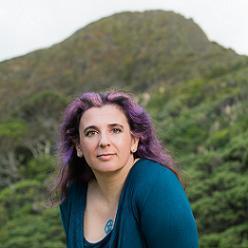 In this week’s podcast episode, I’m talking to Tanja Gardner from Conscious Introvert Success about a topic that is near and dear to my heart: introversion. Tanja is a coach who helps other introverted business owners figure out how to make their heart-based businesses work for them.
In this week’s podcast episode, I’m talking to Tanja Gardner from Conscious Introvert Success about a topic that is near and dear to my heart: introversion. Tanja is a coach who helps other introverted business owners figure out how to make their heart-based businesses work for them.
Topics we discuss include: Why introversion is not the same as being highly sensitive or shy (and certainly isn’t something that needs to be fixed), and what it really means Some of the key traits introverts can have How awareness of your energy levels can transform your life A useful visualisation that will help you manage your energy levels Share the Wisdom
Introversion is not a personality factor, it's an energetic factor.
Click To Tweet - Powered By CoSchedule
Energy is like a bank account; if you want to make withdrawals, you also need to make deposits.
Click To Tweet - Powered By CoSchedule
Conscious Introvert Success – Tanja’s website with tons of information and resources for introverted business owners.
Tanja’s recommended reading list for introverts
Tanja
Twitter:@ConsIntrovert
Website: consciousintrovertsuccess.com
Facebook: Conscious Introvert Awesomeness
Hannah
Twitter: @becomewhour
Website: becomingwhoyouare.net
Get your free ebook on how to overcome the 5 most common blocks to authenticity.
Subscribe to the PodcastIntro and outro: Stephanie Murphy
Image credit: Kimberly Richards
The post #66: How to Thrive as an Introvert with Tanja Gardner appeared first on Becoming Who You Are.










October 26, 2014
Want to Hear “Yes” More Often? Try This Simple Trick.
One of the great things about running my own business is that I’ve learned a *ton* of valuable life lessons. Possibly the biggest one so far is around “yes” and “no.”
In order to get a “yes”, we need to be willing to collect many “no”s.
This isn’t a particularly pleasant experience—as hard as it is to say no sometimes, it’s just as hard (if not harder) to hear no.
But, as uncomfortable as it can feel, the more we’re willing to ask, the more we are likely to get.
I used to think that asking was rude and presumptuous. With most requests I make—whether it’s about collaboration, asking for a favour, requesting an interview, or inviting someone to a coaching session—I still have to remind myself that it’s not rude to ask.
In fact, it’s rude *not* to ask based on the assumption that someone will say no.
After all, who am I to make that decision for them without giving them a chance to decide for themselves?
Let’s talk about “no”…Part of the reason why hearing “no” can be so hard is that it leaves us feeling isolated. We see other people doing the things we want to do and we often see the results of the “yes” at the end of their journey, rather than the slew of “no”s they’ve collected on the way there. We rarely discuss the “no”s; it’s a little ouchy for the ego and maybe, deep down, we still harbour fears of being an impostor.
But the more I thought about this as I was writing this post, the more I realised that so many beautiful things in my life right now have a series of “no”s behind them: I adore working with passionate and inspired people, and I’m able to live wherever I want while I’m doing it. The genesis of this whole journey? I got turned down for a job I really wanted after university, had zero dinero, and no clue what I wanted to do with my life. A couple of months ago, I got married to my wonderful husband, and you know what? I’m so grateful to the people who said “no” to a relationship with me before then and played their own part in shaping my journey towards him (in hindsight—at the time, it sucked). Early next year, I’m going to be sharing interviews with 10-20 of my biggest and brightest role models for a symposium on entrepreneurship I’m hosting with En*theos (can’t wait to share more info with you soon!) I pitched my first idea to them back in April, and it wasn’t a good fit. That opened the way for this new project, which fulfils a big need and about which I’m even more excited. Last week, I had a post published on MindBodyGreen. This is the fourth or fifth time I’ve pitched to them; my other posts were rejected. And that’s cool, I’m pleased I had time to refine my ideas and produce something that felt authentic.
None of these paths have been comfortable. Hearing some of those “no”s was brutal, but all of them led to a bigger and better “yes” in their own way.
“No” is not a bad word—to say or to hear. No is simply part of our journey to "yes".
Click To Tweet - Powered By CoSchedule
Earlier this year, my coach introduced me to “The ‘No’ Game”. Here’s how it works:
Think of something you would like to create (a particular project, a romantic relationship, more clients, a dream vacation), and think about all the requests you’re going to need to make to make that dream a reality.
Now, instead of focusing on whether or not you’ll get the “yes”s that will lead to that outcome, focus on collecting as many “no”s as possible.
Here’s why this works:
When we change our perspective of “no” from something to be avoided to something to be embraced, we transform anxiety around fear or rejection into excitement and possibility. When we’re focused on avoiding a negative response, each “no” strikes an emotional blow that, over time, depletes our willpower. Take the emotional weight out of the word, and our willpower lasts for longer. Reframing “no” in this way also takes the pressure off; it doesn’t matter if we hear a lot of “no”s because that’s the point of the game, right?
Here’s the counter-intuitive kicker: the more relaxed we are, the more likely we are to get our “yes,” even if that’s not what we’re focused on. Neediness is a turn-off, but desperation-free enthusiasm is very appealing.
Finally, getting to “yes” is a numbers game. There are definitely things we can do to shift the ratios in our favour, but when we are willing to put ourselves out there and collect as many “no”s as possible, the more likely we are to collect a few “yes”s at the same time.
Chances are that, right now, there’s something you want or a request you’d like to make. So give this a try; for the next two weeks, rather than worrying about getting a “yes,” focus on reaching out and try to collect as many “no”s as possible.
You game? :)
Thanks for reading. If you know someone who might be interested in this post, please share it using the buttons below.
Want a rock-your-socks self-coaching toolkit and a weekly dose of authenticity? Enter your email below to get access to all this plus The Tribe, our private community for people who are passionate about living more authentic lives.
Get your weekly dose of authenticity hereThe post Want to Hear “Yes” More Often? Try This Simple Trick. appeared first on Becoming Who You Are.









October 17, 2014
How to Shift from Scarcity to Abundance
Today’s post is a recording of a Google Hangout I did for members of The Tribe last week on how to shift from scarcity to abundance. I shared five ideas that we can start using today to go from focusing on “not enough” to cultivating a sense of possibility and ease. Below you can find a video of the Hangout, plus a rough transcript.
TranscriptHi everybody and welcome to this Google Hangout on how to shift from a scarcity mindset to an abundance mindset, or, as I’ve called it, how to shift from scarcity to serenity.
I’m going to be sharing five ideas with you today, but first I’ll just give a quick introduction to who I am, share a brief grounding exercise, and then we can get to it. Before we get started, I just want to let you know that you will get the most out of this webinar if you have a pen and paper to hand as I’m going to be sharing a couple of exercises for you to do as we move through the five ideas and concepts and start to put them into practice.
Before we start, however, I’m going to guide you through a brief grounding exercise. We’re coming here today from different places, with different experiences, with different stuff on our minds and different emotions swirling round, so this exercise is about calming, bringing us all together, and making sure that we’re approaching this from a similar place.
So I just want you to close your eyes, make sure your feet are flat on the floor, your hands are in your lap (obviously if you’re listening to the audio of this and are driving please don’t do this). Then, take three deep breaths.
Return your breathing to normal and do a quick scan of your body for any tension that might be left over from the other parts of your day. Common areas we carry tension are our shoulders, neck and jaw, so pay special attention to those parts. Then take three more deep breaths and open your eyes.
Here’s a brief overview of 5 ideas I’m sharing with you today:
1. Abundance is not about money
2. Focus on what you’re for, rather than on what you’re against
3. Instead of asking “What can I get from this?” Ask “What can I contribute?”
4. Create a vision (but don’t get too attached to the goal)
5.
Be the captain of your own ship
Abundance is not even about what you have, just as scarcity isn’t about what you don’t have. Both abundance and scarcity are about how you relate to what you have or don’t have. So it’s not about how much money you have, where you live, how big your house is, whether you have the latest iPhone 24 or whatever, it’s about how you relate to, feel, and talk about what you do have.
This is where the law of attraction has a point. I’m not a huge fan of the concept as a whole, it’s a little bit too woo-woo for me, but like many movements in the personal development world there are useful ideas that we can cherry-pick and pay attention to in our own lives. One of these ideas is the concept that what you put out, you get back, or, to put it another way, we reap what we sow. If we’re constantly focusing on what we don’t have, we’re sowing seeds of lack and not enough, and that’s exactly what we’re going to get back. Even when we get the things we think we initially wanted, we still feel unhappy, so we look to the next goal to buoy us up.
This starts a cycle that I call the “When…then…” mentality. I call it that because the thoughts we usually have go something like “When I get that job, then I’ll be happy”, or “When I am earning X amount of money, then I’ll feel secure”, or “When I’ve finished this next big project, then I’ll be able to take a break and spend time doing things I really want to do”.
The problem with this mentality is that the goal we’re chasing is not the thing that is actually going to make us happy. When we keep thinking in this way, we give away our potential for happiness, security, satisfaction, or whatever it is we want more of, to our hypothetical future selves and we never get to experience it right now. I can tell you, because I’ve had this mindset and lived this pattern out many times, that we don’t feel happy/secure/satisfied etc. when we reach that goal. Instead, we just look to the next thing that might fill that emotional hole for us.
That’s just one way that we reap what we sow. Equally, if we’re going out into the world with a negative mindset about where we’re at right now, we’re more likely to attract people who share this mindset. If most of what we we talk about is how things are going wrong for us, the problems we’re dealing with, and so on and so forth, we’re more likely to attract people who have a similar mindset and can relate to that, and potentially deter people who are more optimistic, who take responsibility, and take action on the things they want to do.
So abundance is really a mindset. And that’s really, really great news because it means for all of us today wherever we’re at and whatever we’re dealing with, we don’t need to wait until that debt is paid off, or our income goes up, or until we get a new boyfriend or girlfriend to start appreciating what we *do* have and to start enjoying that feeling of peace that comes with accepting where we are right now.
Exercise: So right now, I want you to grab a pen and paper and write down all the “When I have X… then I’ll be happy” thoughts you’ve had over the last couple of days or last week (or any varation of them), especially making a note of what areas of your life they relate to. I’m going to give you about 30 seconds to do that right now.
Now that you have a few examples of where this thinking crops up for you, I want you to spend another 30 seconds or so just thinking about how you can start to generate more of that feeling you want—whether it’s happiness, satisfaction, etc.—in your life right now. It might be that there are certain things you have today that you’re overlooking because you’re focusing on tomorrow, or it might be that you don’t need to meet those goals in order to get those feelings you want to feel—they are accessible to you regardless of whether you achieve or attain that thing or now.
This is an exercise I’d encourage you to build on in your own time. Because we have a limited amount of time today, however, I’m going to move onto the next few steps.
Focus on what you’re for, rather than what you’re againstWhen people talk about an abundance vs. scarcity mindset, they often encourage others to focus on what they have rather than what they don’t have. I’m going to take this a step further today and invite you to focus on what you’re for rather than what you’re against. This is subtly different from focusing on what we have rather than what we don’t have, as it encourages us to approach our thoughts about the future from an optimistic place, rather than just looking at what we have in the present.
If we constantly do things because we’re motivated by wanting to avoid pain, we’re always going to be focusing on the pain in our lives. If, however, we start to do things because we know those things will bring us pleasure and enhance our lives in some way, we’re coming at those activities from a place of having enough already and we’re far more likely to enjoy the process of doing those things as a result.
Exercise is a great example. I don’t know about you, but whenever I’ve exercised because I feel like I’m not enough; not skinny enough, not fit enough, etc. etc. it never works. I might start out with great intentions, but after a while I’ll end up resenting the process, feeling frustrated that I’m not making as much progress as quickly as I might like and therefore amd still feeling “not enough” despite all the effort and energy I’ve put into it so far, and eventually I’ll give up.
If I focus on how I want to feel, however (so, in other words, if I exercise out of a motivation to move towards pleasure, rather than out of a motivation to move towards pain,
Exercise: Where in your life are you focusing on what you’re against? And what would it look like to shift that focus towards what you’re for instead? What would you do differently? What might shift in how you feel?
Instead of asking “What can I get from this?” Ask “What can I contribute?”This shift is probably the idea that has had the single biggest impact on how I relate to my life, especially during times when things aren’t quite going the way I want them or expected them too and I notice thoughts around “not enough” creeping in about myself, my work, and the rest of my life.
It was a real “a-ha” moment for me because in some ways it’s so counter-intuitive. Why, if we’re feeling like we don’t have enough, would we focus on what we can contribute? Surely we’d be looking out to get what we’re needing right?
Well that’s certainly the default position we go to, and it’s a very natural, very human position. If you’ve heard the podcast interview I did with Guy Winch, which is episode 49 of the Becoming Who You Are podcast, you’ll remember Guy mentioning that studies of the human brain have shown that when we experience rejection, it lights up the same parts of our brain as feeling physical pain. So, thinking back to the last point we talked about, if we’re in a scarcity mindset and feeling rejected by or alienated from other people as a result, we’re going to be focused on moving away from pain rather than moving towards pleasure, hence asking “What can I get from this?”
In reality, we get value from giving value. That’s the way our world works, in business, in relationships, and in most, if not all, areas of life. Our friends are our friends because they get value from our presence just as we get value from theirs. We earn money at a specific company or through performing specific services or tasks because those roles, services, or tasks are valuable to someone else.
Although focusing on what we can get from a certain situation is very natural, it’s unlikely to get us anywhere as when we’re in this mindset, we’re focused on taking rather than giving.
Exercise: So again, I want to invite you to think of a situation recently where you notice you went in focusing on what you could get from the situation. Take a few seconds to write it down and write a little about the circumstances. Now, write a few sentences about what you would have done differently if you had focused on what you could contribute instead.
How does that scenario feel to you? I know that when I’ve done this exercise myself in the past, I always notice that the latter scenario feels like a relief, it feels lighter, easier, and far more aligned with how I want to show up in the world. Again, this is an exercise you can build on after this webinar is over, and I encourage you to use this switch-around whenever you notice that you’re putting your energy and focus into what you can get from a certain situation.
Create a vision (but don’t get too attached to the goal)This is another big idea that I’ve found super useful in my life. I used to set goals and get really attached to meeting them, then start focusing on the fact that I wasn’t there yet, how far I was from the goal, and so on, rather than enjoying the process of reaching the goal and being able to look at how far I had come.
Like I mentioned earlier, we want to focus on what we’re for, and this includes creating a future vision for ourselves and creating goals or milestones we’d like to reach. When creating those goals, however, it’s really important to start by focusing on how we want to feel and then creating goals out of those desired feelings (if you’re interested in exploring this process in more depth by the way, I recommend checking out the book The Desire Map by Danielle LaPorte). We all know that doing things because we want to impress other people is not a good plan, so focusing on how we want to feel then pursuing the activities that will generate those feelings for us is a much healthier alternative to this.
When we approach goals in this way, the goal itself doesn’t really matter—it’s the process that really counts.
When we get attached to the goal, our happiness becomes dictated by whether we’ve met said goal or not. In other words, we make that goal way more powerful than it actually is, and the goal starts controlling us, rather than the other way around. In reality, we can shift goals as and when we need to. I don’t know about you, but I’ve started working towards goals in the past and found that new opportunities have come up as a result of my progress towards that goal, or that I get part of the way there and realise that actually the thing I thought was the goal in the first place isn’t really what I want to be doing. Being focused on the process rather than the goal, and keeping in mind that ultimate end goal of how I want to feel, rather than what I want to attain or achieve, allows me to flexible. I’m not approaching the goal from a place of not having enough, I’m approaching it from a place of wanting life to be awesome :)
Exercise: Right now, I want you to put thoughts about all the goals you currently have in your life to one side and instead write down three to five words that describe how you want to feel. Try to be as specific as possible, so instead of writing something like “happy”, try to dig a little deeper and identify what “happy” means to you. Do you mean fulfilled, joyous, inspired, excited, or something else?
Then, after this webinar is over, spend some time thinking about which goals, when you start working towards them, would leave you feeling that way. This will set you up to focus on your goals from a place of abundance and seeking pleasure, rather than from a place of not having enough or being enough.
You are the captain of your own shipThe final idea I want to share with you today is one that underpins everything we’ve talked about so far, and that is the idea of self-responsibility. When we’re operating from a scarcity mindset, we tend to focus on placing blame; we want to hold someone accountable for where we are and how we feel right now, and that’s where a lot of our energy goes. This might be someone else; we might blame our parents, our boss, our partners, or anyone else in our lives, for things that have happened to us or the things we’re struggling with right now. Something I hear frequently as a coach is “I’d love to do XYZ, but my mother/father/sister/brother/husband/wife/friend doesn’t support me.” Or we blame ourselves and we say things like “I’d love to do XYZ, but I’m just not confident/young/skilled” enough. To be blunt, when we say those things, we’re making excuses. Blame is not productive, and it moves us in the opposite direction to experiencing and living abundance.
Wherever you are in life and however you feel about it, it might not be your fault that you are where you are right now—it could totally be due to someone else’s decisions or actions—but the important thing to remember is that you have responsibility for what happens next.
No one else has control over ourselves, and giving other people this control, either by blaming someone else for the fact that we’re not feeling fulfilled, or by waiting for someone to rescue us, is a sure-fire way to slip into the scarcity mindset. I always think this question sounds kind of cheesy, but it’s an important question to ask: where are you giving away your power?
Exercise: A question I’d like you to consider is: Where can I take responsibility for my life? Where am I giving someone else power over my life, either by blaming them for the way things are now, or by waiting for them to rescue me? What would I do differently if I were start acting more like the captain of my ship?
These are not easy questions to answer, but they are an absolute must if we want to shift from scarcity-based thinking and live with the knowledge that this is our life and we absolutely have the power to make decisions that lead to greater abundance, satisfaction and fulfilment.
Wrap-upThis is a huge topic so there’s a lot more I could say about it, but as I wrote about yesterday on the blog, sometimes less is more, and tackling these big juicy topics in small doses allows the information to sink in and for us to take action on the things that we’ve already covered. So if you’d like to hear more about this topic, please let me know. I’m definitely open to doing another webinar on this at some point, or sharing more content around the subject. Equally, if you have any questions feel free to email me at hannah@becomingwhoyouare.net.
If you’re feeling inspired to take any of these ideas further after hearing this and reap the benefits of adopting an abundance mindset in your own life, I would love to support you in a more in-depth and long-term way. I have two spots open in my coaching practice this month, so if you’re ready to make some powerful changes in your own life, drop me an email and we can set up a complimentary session to see if we’re a good fit to work together.
Thanks so much for coming along to this Hangout today, I really hope you’ve enjoyed it and that it’s given you some tools and ideas you can start to use to shift to an abundance mindset in your own life.
See you next time!
Thanks for reading. If you know someone who might be interested in this post, please share it using the buttons below.
Want a rock-your-socks self-coaching toolkit and a weekly dose of authenticity? Enter your email below to get access to all this plus The Tribe, our private community for people who are passionate about living more authentic lives.
Get your weekly dose of authenticity hereThe post How to Shift from Scarcity to Abundance appeared first on Becoming Who You Are.









October 8, 2014
Sometimes, Less Is More
Recently, I’ve been thinking about our tendency (and particularly my tendency) towards “more” as a solution.
When we feel rushed off our feet, we think we need more time.
When we feel stressed about finances, we think we need more money.
When we’re not making the progress we want with a particular idea or project, we think we need to work harder and longer.
When we don’t feel ready to take a big step in life, we think it’s because we need to wait until we have more knowledge or preparedness.
The result of this mindset is that we fall into the busy trap: we try to pile more and more and more onto our plates without remembering that if we want to add something to our life plate, we need to make room for it by taking something off too.
In the running world, there’s a condition called “runner’s fatigue”: some people who run long distances frequently without periodic tapering or adequate training find that their fitness level seems to drop, their recovery time lengthens, they stop being able to run as far and as quickly as they used to. Often, they think this is a sign they need to run more, to get out there more frequently and push themselves to build their fitness back up to what it was.
In reality, the only way to overcome runner’s fatigue is to run less; to devote proper time to recovery and to mix runs with swimming, cycling, or other cross-training. As counter-intuitive as it sounds, it’s only through running less that their fitness and energy levels return to what they were before.
I have to remind myself of this periodically in business and personal projects. When things aren’t moving quite as fast as I want them to, I immediately jump to the conclusion that I need to do more—more blog posts, more marketing, more of all the things.
Most of the time, however, more is actually the problem. I over-commit, spread myself too thin, then feel overwhelmed and frustrated.
When I find myself in this place, I know it’s time to take a step back and, rather than doing more, to do less (easier said than done!) This is the time to re-prioritise, go back to my core values, and focus on the things that are really important. It’s also the time to remember that not everything is going to happen right now, and that that’s OK.
Sometimes, less leads to more.
Click To Tweet - Powered By CoSchedule
Rather than needing more time, maybe it’s about spending less time on commitments that are not longer serving us.
Rather than earning more money, maybe it’s about spending less money on things that aren’t a priority to us.
Rather than working longer or harder, maybe it’s about doing less busy work and focusing on the activities that will get us closer to where we want to be.
Rather than needed more knowledge or preparedness, maybe it’s about having less expectations and attachment to a particular outcome and diving in with the intention to enjoy the process.
Today, I invite you to think of an area of your life where you’re telling yourself you need to do more or be more.
What if the path to satisfaction lies not in more, but in less?
Are you feeling stuck on a particular goal or project? From Stuck to Started will give you clarity, motivation and a clear plan of action. We’ll work through any obstacles and self-limiting beliefs and leave you with a toolbox of ideas and resources you can use to make sure you get to where you want to be and have fun in the process. Find out more here.
Thanks for reading. If you know someone who might be interested in this post, please share it using the buttons below.
Want a rock-your-socks self-coaching toolkit and a weekly dose of authenticity? Enter your email below to get access to all this plus The Tribe, our private community for people who are passionate about living more authentic lives.
Get your weekly dose of authenticity hereThe post Sometimes, Less Is More appeared first on Becoming Who You Are.











